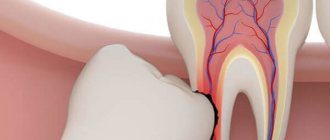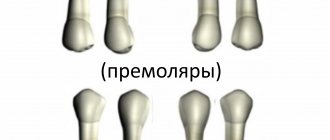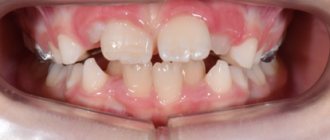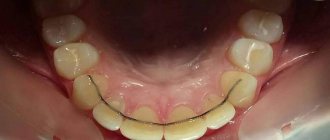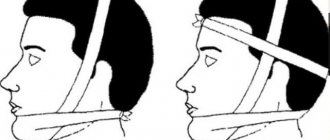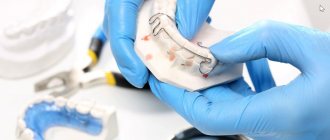- Features of jaw development at 8–13 years of age. Changeable bite
- Main products and rules of care How to choose a toothbrush
- How to choose toothpaste
- Additional tools
A child gradually entering adolescence experiences many dramatic changes in his body, and the oral cavity is no exception. How to take care of your teeth and gums during this period, what products to choose so that the change of baby teeth is easy and correct - we will tell you in today's article.
Features of jaw development at 8–13 years of age. Changeable bite
The main thing that happens to a child’s teeth at this age is that they change to permanent ones. This condition of the jaw in adolescents is called a mixed bite.
By the age of 3, the child has 20 temporary teeth, which began to grow from the age of six months. They are gradually replaced by indigenous ones (with normal development, complete replacement occurs by 13–14 years). 8–12 chewing teeth also appear, which immediately erupt as permanent teeth.
During the period of change of occlusion, the roots of baby teeth dissolve, preparing the place for new, permanent teeth. The change in bite begins at the age of 6 and lasts for the next 8. The sequence of teeth change is the same for all children, but the boundaries of the periods may vary. The front milk teeth are the first to be renewed - just remember the photographs of first-graders on school rulers! At this time, children's jaws are actively growing, and gaps appear between the teeth necessary to freely accommodate molars - they are always larger than baby teeth. Constant changes in the structure of the jaw will occur in a child up to 14 years of age.
The formation of a bite is a very long and important process, on which the health and appearance of the child in the future largely depends. Therefore, it is necessary that from 6 to 14 years of age he undergoes an annual examination by an orthodontist. The doctor will ensure that the teeth are correctly positioned in the dental arch, and will also monitor their size, shape, and enamel characteristics. It is much easier to track bite deviations in childhood or adolescence than to correct them when the child grows up.
What is mandibular hyperplasia?
Hyperplasia is characterized by a constant or rapidly growing condyle when growth should be slowed or stopped. This condition causes development of the head, neck and jaw, causing significant functional and aesthetic deformities of the face. Disorders of the dental craniofacial structure affect the normal growth of the jaw, which leads to gross changes in the normal morphology and structure of the hard and soft overlying tissues. The result is asymmetry and significant functional deformities, which pose a serious problem for both orthodontists and maxillofacial surgeons.
Main means and rules of care
A toothbrush and toothpaste are the main tools for caring for a child’s oral cavity. They should be chosen with great care.
How to choose a toothbrush
A common mistake is choosing a brush with too stiff bristles. Do not buy these so as not to injure the delicate gums and developing enamel of the child’s teeth. The bristles should be soft or medium soft, the brush head should be small. It would be good if the brush had a non-slip handle. Be sure to teach your child the correct cleaning technique - the movements should be sweeping, from top to bottom on the upper jaw and from bottom to top on the lower jaw. Movements from left to right not only leave uncleaned plaque on the teeth, but also damage the enamel.
A manual brush cleans plaque no worse than an electric one, but only if the cleaning technique is perfect. In addition, electric brushes, due to their bright design and unusual design, are more popular with children; with their help, it is easier to instill a love for oral hygiene. Remember that until around age 11, when your child's motor skills are fully developed, you still need to supervise his brushing.
How to choose toothpaste
Buy pastes containing strengthening components: hydroxyapatite, calcium or fluorine. They will help strengthen the enamel and prevent the development of caries. The optimal concentration of fluorides in the paste is up to 900 ppm (that is, 900 parts per million). Pastes with higher concentrations are used only in courses and as prescribed by a doctor. Remineralizing gels will provide excellent additional protection against caries.
Biorepair Junior toothpaste with mint flavor (from 6 to 12 years)
Tooth gel GC Tooth Mousse Multifruit
Gel for strengthening teeth ROCS (ROCS) Medical Minerals with fruit flavor…
Do not buy toothpastes with a high index of abrasiveness (RDA) - they polish and brighten teeth, but can damage the enamel. Pastes with an abrasiveness of up to 50 RDA are suitable for teenagers; this is enough for gentle cleansing. For whitening, it is better to choose toothpastes with natural enzymes (bromelain and papain). Pastes should not contain parabens or foaming agents (SLS, SLES).
Additional tools
Additional, but no less important components of care are dental floss and an irrigator (its use is mandatory if the child wears braces). With the help of these tools, the child will be able to thoroughly clean the interdental spaces that no brush can handle, even with the perfect cleaning technique. It is also a good idea to use rinses or special foams. They are convenient to use when it is not possible to brush your teeth, for example, at school or while traveling.
The natural sweetener xylitol will be a good helper in caring for your child’s teeth. It is added not only to candies and chewing gum, which can usefully replace regular ones, but also to toothpastes. The xylitol in their composition helps fight cariogenic bacteria and also takes care of the gums.
Chewing gum miradent Xylitol For Kids apple
Lollipops miradent Xylitol Drops mint
Chewing gum The Humble Co. Tropical Fruits
Fuzzy Rock Xylitol Crystals, Sugar Free, Peach Flavor
Causes of hyperplasia
(MG) is caused by overdeveloped, aggressive growth of the condyle. This condition causes abnormal jaw growth, which means one side of the jaw stops growing earlier. Juvenile idiopathic arthritis (JIA) and condylar fractures can cause growth and mandibular problems. Inflammatory and/or mechanical damage to the condylar cartilage often causes jaw hyperplasia.
Symptoms of inferior hyperplasia
Symptoms include slowly progressive unilateral growth of the condyle of the head and neck. This results in malocclusion, facial asymmetry, and a shift to the middle of the chin on the unaffected side. Characteristics of condylar hyperplasia may also include: a posterior open bite or tilted occlusal plane, depending on the time at which the hyperplasia develops, and asymmetry of the lower half of the face. Characteristic symptoms of lower hemisphere hyperplasia are asymmetrical facial bones (enlarged lower facial bones on one side).
How to motivate your child to brush their teeth
The variety of oral care products today is so great that teaching a child about dental hygiene has become much easier than before. Beautiful toothbrushes with favorite cartoon characters on the body, “delicious” toothpastes, mobile applications that turn brushing into a game - all this helps to develop pleasant associations. Brush your teeth together and praise your child for how well he does it.
Oral-B Vitality Kids Frozen D100.413.2K
Oral-B Pro 2 Junior Sensi Star Wars D501.513.2
Philips Sonicare For Kids HX6322/04 (HX6392/02)
Xiaomi Soocas Kids C1
Make sure that you spend at least two minutes brushing your teeth - place an hourglass on the sink, use a toothbrush with a built-in timer, or a special application on your smartphone.
An effective tool for caries prevention for children is plaque indicators. These are tablets and liquids that color the plaque in bright colors. This way, you can understand which areas need special attention when brushing and whether it’s time to contact a specialist, and the child will have a lot of fun looking at his multi-colored teeth. And he will probably want to repeat the cleaning with better results!
miradent Plaque Agent Plaque Indicator Rinse
Curaprox PCA 223 plaque indicator tablets
miradent Mira-2-Ton Plaque Indicator
miradent Plaque Check dental mirror
Take your child to a dental hygienist - clinics tell you well and clearly about how to care for your teeth and what will happen if you don’t. In addition, children are often motivated by themed cartoons. Show that you can take care of your teeth with pleasure - and the child will do it without unnecessary coercion.
All the most necessary hygiene products for children from 8 to 13 years old are collected in our children's set No. 3. It includes: an electric brush with Frozen or Star Wars cartoon characters, two toothpastes, preventive foam with calcium to strengthen enamel, chewing gum with xylitol and tablets for plaque indication. These are basic products that will help your child maintain healthy oral microflora and fight tooth decay.
What can cause hypoplasia of the lower jaw?
Mandibular hypoplasia tends to be a congenital condition, however, it can definitely occur due to trauma or. Mandibular hypoplasia indicates an incomplete jaw. The radiographic appearance of maxillary and mandibular lesions often includes radiolucency with poorly defined or even irregular diffuse borders. Expansion of the orbital border usually creates hypoplasia and poor pneumatization of the ipsilateral maxilla. Possible hypoplasia of the body of the lower jaw, an abnormal coronoid process, as well as a zygomatic arch.
How is hypoplasia of the lower jaw treated?
To lengthen the mandible in situations such as mandibular hypoplasia or post-traumatic defects of the mandible, gradual distraction of the bone tissue is required. Treatment will depend on the degree of midfacial hypoplasia as well as the structures involved. Most patients with craniofacial microsomia actually have a level of mandibular hypoplasia, which is clinically seen as a form of receding chin and asymmetry at the corners of the mouth. There is hope for those suffering from mandibular hypoplasia, but it requires a reconstructive surgical procedure. The extent of the operation depends on the level of underdevelopment, as well as on the configuration of the surrounding tissues and muscles of the face.

